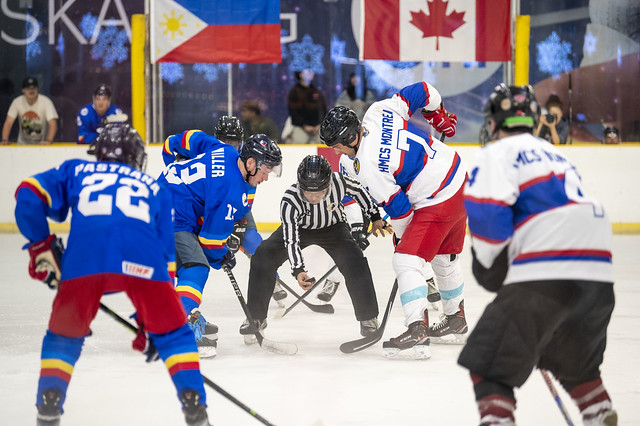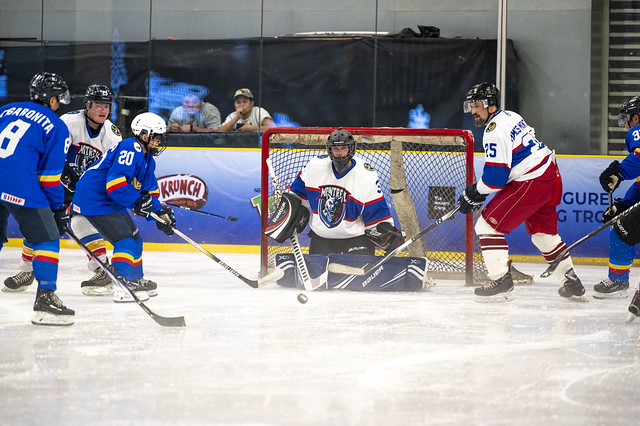Rinks have now begun to sprout all over South-East Asia, helping those people to see what winter could be like. That and the help of expatriate (expat) Canadians homesick for their national sport, have introduced the game of hockey, and shared it with the local populace, helping to grow the sport. The cost of the sport, equipment, ice rinks and ice time costs have been the barriers to the growth of the sport in the region. But it hasn’t stopped hockey from taking root.
Related: Canadian Navy Team Helps Sell Hockey in Philippines
This makes sense as the Philippines and Canada have close ties, as there are close to one million people of Filipino descent living in the northern nation. Being that large of a community hasn’t gone unnoticed by the national sport either as the NHL’s Winnipeg Jets held a Filipino Heritage night. But, has this made an impact in the Philippines? Yes, it has, and there is no question that the sport and the talent pool are on the rise.
The Philippines Has a National Hockey Team?
Yes, they do. While this is a common first question, it’s understandable. Basketball is the national sport added to that, the Philippines is a tropical nation and not one that has a large middle class that can spend on sports. Hockey is expensive, and relies on cold weather, so asking this makes sense. But that doesn’t change the fact there is a passionate fanbase making hockey a niche sport in the Island nation. Over the years, Canadian players were imported by expat Canadians who, as Canadians do, began their own pickup league to enjoy their sport. Locals began to take notice. As it was new to the nation, they took time to warm up to it and once they did, those expats began to pass their hockey skills to the locals.

After some time, and more locals taking up the sport, the Philippines joined the International Ice Hockey Federation (IIHF) and as of August 2024 they are a nation of three arenas and approximately 315 players nationwide. They made their national team debut at the 2017 Asian Winter Games and ended with a very impressive third-place finish. They then took another step forward when they hosted the Challenge Cup of Asia in 2018, and earned another third-place finish. At the Southeast Asian Games in 2019, the Filipinos were able to win a bronze medal on home ice, in front of a sellout crowd (approximately 350) when they dominated Malaysia by a score of 17-1.
The upward trajectory was due to be continued from there and four years after joining the IIHF, they applied for the 2020 WCs, where they joined Division IV, the lowest division and played in the tournament that was to be held in Bishkek, Kyrgyzstan. Unfortunately, the COVID-19 pandemic struck and it forced the cancellation of that tournament. And again in 2021 and 2022, forcing the Filipino squad to wait three years for their major IIHF tournament debut.
International Recognition
For those who are unaware, the World Championship isn’t just the one seen on TV in North America, the one where Canada, the United States, Russia and other major hockey powers compete. There are four Divisions. The Filipinos were about to debut on the world stage, albeit at the entry-level, but it is still a IIHF event featuring some world-class hockey. Even though the Philippines are a “have not” in the hockey world, with the deck stacked against them when it comes to their fledgling hockey program, they have been able to prevail at every step. Now, thanks to the challenges they faced in the minor international tournaments, and the lessons learned, they felt ready to faceoff for Division IV.

In their first appearance, they finished first, winning gold in the 2023 Division IV World Championship. It’s not the top of the IIHF pyramid, but to win a tournament is nothing to be scoffed at, especially with a fledgling program that has less than 400 players (if you count both men and women) in the entire nation. It was frustrating for the Filipinos to miss three World Championships due to the pandemic, but perhaps that extra time allowed them to better prepare. Either way, the frustration from waiting was washed away with their victory, and graduation to Division III B.
“It was a great experience. It was our first Worlds, and moving up in the ranks we knew the competition would be faster and more skilled with better systems. Before it was all run and gin teams, now we have to focus more on systems, So, Philippines we’re a smaller team so we just had to adjust to deal with bigger teams like Bosnia.”
– Manny Billones, Philippines National Team captain
In February 2024, the Filipinos arrived in Sarajevo Bosnia Herzegovina for the 2024 Division III Group B tournament. Not much was expected from the upstart South East Asian nation as most of the time, the new arrivals cannot adjust to the increased level of competition. However, they bought into the new systems installed by head coach Juhani Ijäs, as they dominated the Iranian team 14-2. They followed that up and beat the Singaporean club by a 6-3 score, thanks to a disciplined style based on speed. While they finished the tournament with two wins and four losses, the fourth loss came in the bronze medal game, giving the Philippines a respectable fourth-place finish in their first appearance in the third division.
What’s Next for the Philippines?
The next step for the program is to return to the Division IIIB tournament in 2025, this time it will be held in Mexico. Team Mexico was relegated after the 2024 Division IIIA tournament but will now host the Philippines, North Korea, Hong Kong, Singapore and Mongolia. Last year, the Filipinos had issues against Bosnia, but without them in the picture this year, there is an unmistakable confidence in their tight-knit group. Their goal is not just to help the program improve, but to win gold. Team captain Manny Billones understands the steps it takes, and credits the influx of fresh ideas to their current success.
“It was definitely a process, we were running through different coaches and the commitment level didn’t seem there as everyone still has to work, so coming here late at night to practice was hard. Eventually, we bought into the system, and then we had just one goal which was keep winning gold and moving up. The new coaches from outside the Philippines helped us a lot. They got us to be more physical. That was new to most of us, so a lot of adjustments were made.”
– Manny Billones
In conversation with Ian McGrath, the National Team assistant coach, the gold medal win in 2023 was a spark that has helped the grassroots game in the Philippines stating that “it is up to the coaches to keep the fire, the desire to compete, lit.” The impact had by having these wins and seeing teams come to play in friendly matches like the one played against the HMCS Montreal when they visited in August 2024 brings more eyes onto the game. But, for anyone who has been in Manilla and witnessed the interest these games generate, you instantly see the wonder the local children had in watching their first-ever game. Several kids were hooked.
Growing the grassroots of the game in the country is the ultimate goal. That growth someday will also have an impact at the NHL level. Players of Filipino descent in the NHL, like Jason Robertson and Tim Stapleton, add to the diversity of the league. While they are American-born, they represent their heritage proudly, which inspires a nation that is not a traditional hockey market. Just like the growth of the NHL in the Sunbelt, these players and programs such as the Filipino one, will bring in more players from the grassroots which in turn will increase the talent pool that can be chosen from.
As talented and determined as the current crop of National Team players are, there is a need to keep the pipeline flowing, and as more players take up the game, more attention locally and internationally will come. This will help bring in sponsors, funding, coaches and refinement of the game nationally. The hard work and late nights will continue at the Mall of Asia and elsewhere in the nation. It will be a grind to find, develop, and equip, but it must continue. The Division IV gold medal put them on the Filipino sporting map, but dedication from the coaches and players alike is required to continue their meteoric rise in the IIHF rankings. But more so to overcome the hurdles that lay in front of them in growing the sport at the grassroots level to ensure the program’s longevity as well.
